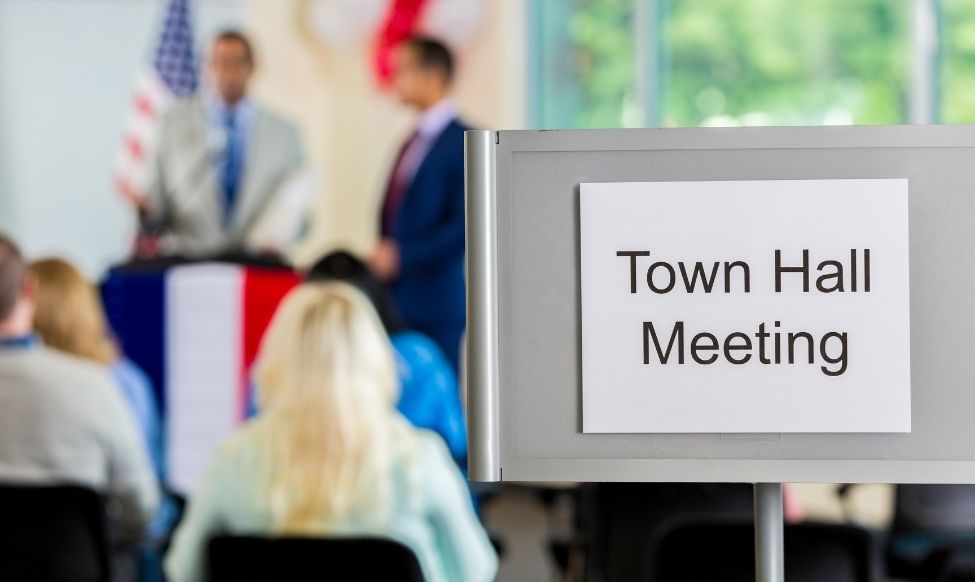For those who hoped never to hear the phrase “new normal” again… we’re not there yet.
Yes, we are getting back to a “new normal” as the pandemic continues on. And while the Delta variant is posing continued challenges, many in-person activities have resumed. But for municipalities, with new updates to the New York State Open Meetings Law, maybe a hybrid style model is the best way to expand public engagement and follow the new guidelines.
New York Open Meetings Law
Governing state and local government meetings is a piece of legislation that covers public bodies such as municipalities. Known as the New York Open Meetings Law, or OML, Section 103 of the Public Officer’s Law states that public bodies at the state and local level in New York must give notice of meetings and allow the general public to attend at a facility that permits barrier-free physical access.
According to Section 102 of the OML, public bodies are defined as any entity that requires a quorum to “conduct public business and which consists of two or more members, performing a governmental function for the state or for an agency or department thereof.” Therefore, a public body is any state, county, or municipal government. And a quorum means a majority of body members needed to take formal action of matters of public business.
Essentially, the OML gives citizens the right to attend and listen to the deliberations and decisions that go into the making of public policy in an open and public manner, enabling them to educate themselves on current legislation and observe the performance of public officials.
New York State Response to COVID-19 and the OML
On March 12, 2020, former Governor Cuomo issued Executive Order 202.1. The order suspended the requirement that members of a public body physically convene; now, teleconferencing was permitted. Therefore, instead of providing a meeting location where the public could gather, if a municipality wanted to host a meeting, the Executive Order mandated that the municipality had to provide remote access to the general public.
In addition to suspending certain requirements such as an in-person and physical location, some new requirements were also established for the duration of the Executive Order 202.1 such as recording and transcribing meetings.
OML Fully Functioning Again?
On June 25, 2021, the State Disaster Emergency ended, removing the provision that suspended the Open Meetings Law. So this summer, the aspects of the OML related to in-person attendance (that were previously suspended) went back in effect.
Many municipalities found the shift back to in-person meetings startling. When the pandemic began, it had been a challenge for many municipal and state boards to gain familiarity with platforms such as Zoom. However, many members of the general public attending the meetings virtually quickly became accustomed to the ability to watch and participate in municipal meetings from the comfort of their own home. As more municipalities and the public became used to hosting and attending virtual meetings, it quickly became commonplace and convenient. The many positive outcomes of these meetings included that people who had never participated in the municipal process in the past were able to watch, listen and comment – estimates suggesting that public engagement actually increased during an otherwise dark time.
Virtual Access Extended
So with the Open Meetings Law fully functioning again, that means all government meetings need to be held in-person again, right?
Not so fast. Earlier this September, Governor Hochul signed legislation extending virtual access to public meetings. This means that meetings can be held remotely again as long as the public has the ability to view or listen to the meetings, and as long as the meeting is recorded and later transcribed.
For municipalities who were hoping for in-person meetings again but enjoyed the increased engagement of virtual meetings, perhaps a compromise with a hybrid style model is the best option.
What Would a Hybrid Style Look Like?
If a municipality were to host a board meeting implementing a hybrid style model, then the meeting could be held in the usual physical meeting spot in addition to on Zoom or another video platform. This way, public engagement could be maximized to its full potential and follow Governor Hochul’s legislation at the same time.[1]
A hybrid style could also address the matter of accessibility and inclusivity. People that don’t have cars or access to transportation could continue to attend virtual meetings and stay in the loop. After all, communities work best when the people living in them and the people leading them work together. Therefore, hybrid-style meetings are a solution to improve outreach, participation, and inclusivity. While the pandemic disrupted most of our lives, municipalities should capitalize on the opportunity to collaborate with the public and find more ways to include everyone.
Questions on how to navigate the Open Meetings Law now that virtual meetings have been extended? Contact us at 631-738-9100.
[1] If a municipality wishes to host a virtual meeting only (without a physical location tied to it), then Governor Hochul’s legislation allows this option.

